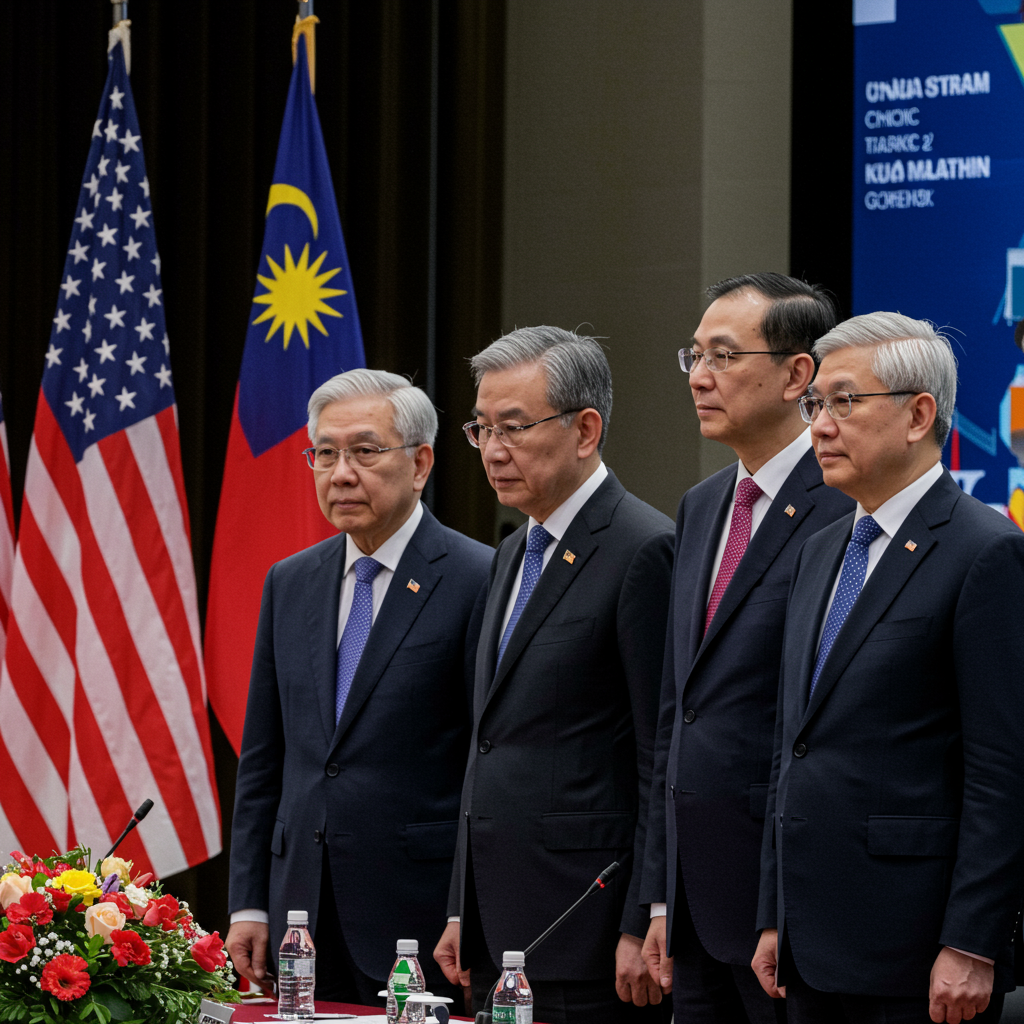The global economy holds its breath as crucial US-China trade talks begin in Kuala Lumpur, Malaysia. These high-stakes discussions, initiating on October 25, 2025, aim to de-escalate simmering trade tensions between the world’s two largest economies. They also pave the way for a highly anticipated summit between US President Donald Trump and Chinese President Xi Jinping. With a fragile truce set to expire, the outcomes of these engagements could significantly reshape international trade dynamics.
High-Stakes Diplomacy Kicks Off in Kuala Lumpur
On a pivotal Saturday morning, high-level delegations from Washington and Beijing converged in Malaysia’s capital. The venue for these critical talks was the 96th floor of the Merdeka 118 tower, Malaysia’s tallest skyscraper. China’s delegation, comprising approximately 20 officials, arrived just before 11 AM. It was led by Vice-Premier He Lifeng, a close associate of President Xi Jinping, alongside key trade negotiator Li Chenggang. The US team, already present, was spearheaded by Treasury Secretary Scott Bessent and included US Trade Representative Jamieson Greer.
Initial reports from the US delegation described the first day of discussions as “very constructive.” This positive assessment provides a glimmer of hope amidst a period of intense economic friction. These face-to-face engagements represent the fifth meeting between Vice-Premier He Lifeng and Treasury Secretary Scott Bessent. Their previous encounters since April reflect ongoing efforts to manage and de-escalate the persistent trade dispute. The discussions were slated to continue into the evening, with a possible resumption on Sunday, signaling the comprehensive nature of the issues at hand.
Unpacking the Agenda: Tariffs, Tech, and Trust
The core objective of these Malaysian US-China trade talks is to prevent a further escalation of the ongoing trade war. Both nations have implemented retaliatory measures, creating a complex and volatile global trade landscape. The agenda is packed with contentious issues that demand immediate attention:
Tariff Relief: President Trump publicly acknowledged the unsustainability of the current 157% tariff rate on Chinese goods entering the US. He noted China’s strong desire for reductions. In return, the US seeks specific concessions.
Rare Earths: China’s tightening export controls on rare earth minerals, vital for defense and high-tech industries, are a major point of contention. US officials like Bessent and Greer condemned this as a “global supply chain power grab.” Washington is actively diversifying its supply chains, exemplified by a deal with Australia for critical minerals.
Technology Controls: The US is considering new measures, including significant curbs on software-related exports to China. This could fulfill Trump’s threat of restricting “any and all critical software,” impacting a wide array of products from laptops to jet engines.
Agricultural Purchases: The US demands China resume purchases of American soybeans. This issue has significantly impacted US farmers facing large crops and fewer buyers.
Fentanyl Action: Stronger action against fentanyl production and trafficking from China is another key US demand.
Phase One Agreement Adherence: The US Trade Representative launched an investigation into China’s adherence to its commitments under the 2020 “Phase One” trade agreement. This assesses any non-implementation on US commerce.
These comprehensive discussions highlight the intricate challenges in the bilateral economic relationship.
A Fragile Truce: The Road to Kuala Lumpur
The current round of diplomacy follows a significant fraying of a “delicate trade truce.” This truce had been established over four previous meetings since May. It initially reduced US tariffs on Chinese goods to roughly 55% and Chinese tariffs to about 30%, and restarted the flow of rare earth magnets. However, this fragile peace began to unravel in late September. The US Commerce Department expanded its export blacklist, automatically including thousands more Chinese firms. China retaliated on October 10 by imposing new global export controls on rare earth magnets and minerals. These were explicitly aimed at preventing their use in military systems.
These actions prompted President Trump to threaten new 100% tariffs on Chinese imports and other trade curbs starting November 1. Earlier in October, he even considered canceling his anticipated meeting with President Xi. These developments underscored the escalating trade tensions and the urgency of the Kuala Lumpur talks. China’s Ministry of Commerce convened an unusually large meeting in Beijing on October 20. It aimed to reassure international businesses that its latest export controls were not intended to restrict normal trade activities. This further illustrates the sensitive nature of the current economic climate.
Global Ripple Effects: Beyond Bilateral Disputes
The US-China trade talks are not happening in a vacuum; they reflect a broader, volatile global trade landscape. President Trump’s aggressive tariff strategy extends beyond China, demonstrating his commitment to leveraging tariffs for national security and economic interests.
US-Canada Trade: President Trump recently announced the immediate termination of all trade negotiations with Canada. This followed a Canadian advertisement criticizing tariffs. Trump cited Canada’s “egregious behavior” for the decision, impacting a $900 billion annual trade relationship.
India Trade Deal: The US and India are nearing a trade deal that could significantly reduce tariffs on New Delhi’s exports from 50% to 15-16%.
Automotive Industry: The White House is easing tariffs on the US auto industry. This move was welcomed by carmakers who had lobbied for relief from higher import duties.
Drug Pricing: Trump is intensifying pressure on US trading partners over drug pricing. He is preparing a probe that could lead to new tariffs in the pharmaceutical sector.
Economic Cost: Goldman Sachs estimates that Americans will bear over half the cost of Trump’s tariffs. Companies pass on increased prices, as seen in a 41% surge in coffee prices year-over-year in September due to tariffs and weather.
Legal Challenges: The US Supreme Court is set to hear a crucial challenge to Trump’s sweeping “reciprocal” country-by-country duties. A ruling against these tariffs could significantly impact the administration’s overall tariff strategy.
The strategic moves by the Trump administration also include seeking “cudgels” against China. A deal with Australian Prime Minister Anthony Albanese to secure critical minerals is interpreted by analysts as directly aimed at reducing China’s dominance.
The Path Forward: APEC Summit and Looming Deadlines
The Kuala Lumpur talks are a critical precursor to an anticipated meeting between President Trump and Chinese leader Xi Jinping. This high-stakes summit is scheduled for Thursday, October 30, on the sidelines of the Asia-Pacific Economic Cooperation (APEC) leaders’ summit in South Korea. The timing of these trade discussions also coincides with President Trump’s visit to Kuala Lumpur for the Association of Southeast Asian Nations (ASEAN) meeting, scheduled from October 26 to 28.
President Trump has consistently emphasized his desire to secure a “good” deal with China. He seeks to bring an end to the trade war. His potential discussion topics for the APEC meeting include:
Interim relief on tariffs.
Technology controls.
Chinese purchases of US soybeans.
The issue of Taiwan (though no visit planned).
The release of jailed Hong Kong media tycoon Jimmy Lai.
China’s assistance in dealings with Russia.
The current trade truce between the two nations is set to expire on November 10. This underscores the immense urgency surrounding these ongoing negotiations and the upcoming presidential summit.
Expert Perspectives on a Volatile Landscape
Experts are viewing the current situation with apprehension. Josh Lipsky, International Economics Chair at the Atlantic Council, highlighted the immediate challenge for officials. They must mitigate disputes over US technology export curbs and China’s rare earths controls. Lipsky expressed skepticism that China would agree to reverse its rare earth controls, noting they represent China’s “primary leverage.”
Scott Kennedy, a China economics expert at the Center for Strategic and International Studies, emphasized the high stakes. The outcome of the Trump-Xi meeting will determine whether Beijing’s rare earth gambit successfully counterbalanced US export controls. Alternatively, it could merely induce a continued escalatory spiral. Kennedy warned that if no deal is reached, both sides should prepare for a significant worsening of relations. The comprehensive US-China trade talks in Malaysia are thus not just about economics; they are about setting the trajectory for future global stability.
Frequently Asked Questions
What are the primary issues being discussed in the US-China trade talks in Malaysia?
The current US-China trade talks in Kuala Lumpur, Malaysia, are focusing on several critical and contentious issues. These include reducing tariffs imposed by both sides, particularly the high 157% US tariff rate on Chinese goods. Discussions also cover China’s recent export controls on rare earth minerals, US curbs on software-related exports to China, and ensuring China’s adherence to its “Phase One” trade agreement commitments. Additionally, the US is pressing for increased Chinese purchases of American soybeans and stronger action against fentanyl production and trafficking. These issues are central to de-escalating the ongoing trade tensions.
Where are the upcoming high-level discussions between President Trump and President Xi scheduled to take place?
Following the US-China trade talks in Malaysia, President Donald Trump and Chinese President Xi Jinping are scheduled to meet on the sidelines of the Asia-Pacific Economic Cooperation (APEC) leaders’ summit. This high-stakes summit is set to commence on Thursday, October 30, in South Korea. The Kuala Lumpur talks are viewed as a crucial precursor to this presidential summit, aiming to lay the groundwork for potential breakthroughs in the strained bilateral economic relationship before the current trade truce expires on November 10.
How do the current US-China trade tensions impact global supply chains and businesses?
The escalating US-China trade tensions have significant impacts on global supply chains and businesses worldwide. China’s controls on rare earth exports, for instance, threaten critical sectors like defense and high-tech industries reliant on these minerals, prompting the US to diversify its supply chain through agreements with other nations. Proposed US export curbs on software and potential new tariffs create uncertainty, forcing businesses to re-evaluate sourcing, production, and market access strategies. Goldman Sachs estimates that tariffs are costing American consumers through increased prices, while agricultural sectors face disrupted markets. This volatility makes long-term planning challenging and can lead to increased operational costs for many international businesses.




